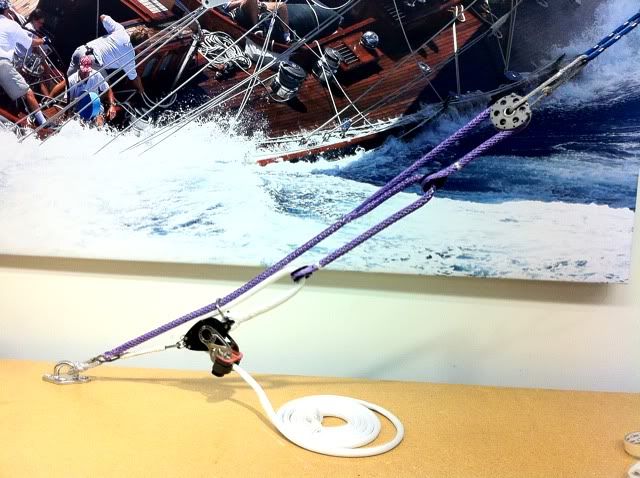Boom vang
Moderator: GreenLake
23 posts
• Page 1 of 2 • 1, 2
Interesting. Very cool looking, at the very least. I got the West Marine 15:1 vang that was on sale last November for dirt cheap, but would totally be up for something like that if I hadn't.


Formerly 28 cents
DS1 1114
Now, sadly, powered boating...
DS1 1114
Now, sadly, powered boating...
- ctenidae
- Posts: 243
- Joined: Mon Oct 05, 2009 8:25 am
- Location: Norwalk, CT
ctenidae wrote:Interesting. Very cool looking, at the very least. I got the West Marine 15:1 vang that was on sale last November for dirt cheap, but would totally be up for something like that if I hadn't.
Curious.
How's that one configured to get the 15:1? I talked to somebody at West Marine this spring, but I don't think he included a 15:1 among the options he showed me (and none were complete kits).
~ green ~ lake ~ ~
- GreenLake
- Posts: 7311
- Joined: Mon Jun 18, 2007 3:54 am
I ended up purchasing the same 15:1 vang - they were cheap because West was no longer going to carry. It is a Harken product with a 3 pulley system pulling a 5 pulley system. Here is a link to Harken's website on it:
http://www.harken.com/pdf/4928.pdf
http://www.harken.com/pdf/4928.pdf
DS I #3056
- itsermam
- Posts: 23
- Joined: Sat Mar 27, 2010 11:36 pm
- Location: Portland, OR
I would have to give that one low marks for efficiency and friction. And, in my opinion it's not powerful enough. If all you want out of the vang is to keep the boom from rising on a broad reach or a run, well then okay. However, if you want some sail control out of the vang I think a minimum purchase power would be 12:1. Those West Marine Harken vangs look quite good, especially if you get them cheap.
After trying 12:1 I decided to go ahead with 20:1, as recommended by many of the top sailors in the class, and find that it works quite well. I think using high-quality blocks, with ball bearings, at all the friction points is huge.
After trying 12:1 I decided to go ahead with 20:1, as recommended by many of the top sailors in the class, and find that it works quite well. I think using high-quality blocks, with ball bearings, at all the friction points is huge.
KC Walker, DS 1 #7002
- K.C. Walker
- Posts: 1335
- Joined: Sun Jul 06, 2008 10:50 pm
- Location: North Stonington, Connecticut
K.C., I don't know whether you've ever posted any picture of your setup, but you did post Mike Gillum's setup here:

Mike's setup marries a 4:1 cascade with a 6:1 purchase, so that should be a 24:1 total purchase in the ideal (friction free) case. The various lines run altogether around 9 sheaves. This makes for an interesting challenge in estimating the losses due to friction.
I calculate the actual purchase as P = 24 - 96 * loss + 188 * loss * loss, where "loss" is the percentage loss at each sheave. The full formula has terms with higher power of loss, in this case up to sixth power, but since we assume that the loss is a few percent (much less than 50%) the first three terms should be enough for a good approximation.
For 5% loss, the purchase effectively acts as a 19.5:1 purchase.
For 10% loss the vang effectively acts as a 16:1 purchase.
Even the best Harken TTR blocks with claimed 2% loss, would reduce the vang to a 22:1 purchase.
Now, the interesting thing about this, is that the loss in the cascade could be made higher (by using eyes instead of blocks) without changing these results dramatically.
What happens if these latter stage blocks / eyes have 4 * the loss?
The formula then becomes P = 25 - 132 * loss + 404 * loss * loss., where 'loss' is the first stage loss, and the assumption that the loss at each stage of the cascade is higher, has been worked into the formula.
For 5%/20% the calculated purchase is 18.5:1, which is really not much worse than what we get with 5%/5% loss.
For 10%/40% we still get a 15:1 (now as loss figures approach 50%, the approximations in the formulas will no longer hold, so the real number may be lower, say 12:1).
Using super-duper blocks in the tackle and standard blocks in the cascade, or the 2%/8% case, would result in a 21.5 purchase.
So, it seems that J24 vang, isn't quite as terrible as it looks - however, it could use a better purchase in its initial parts, by adding a tackle (I have no idea whether the J24 vang is operated with a winch).
The problem with a cascade is always that the range of adjustment is so limited. Otherwise, the most efficient approach might be a 16:1 cascade....
A 16:1 cascade would use fewer parts which should make it competitive against variations of the vang as discussed so far that don't involve the final block in the deck and therefore only get a 20:1 ideal purchase, but with nearly the same losses. (If the cleat is at the lower block, as is common, then the tackle is rove "to disadvantage" and you get only a 5:1 purchase).
(A link to a nice explanation of the theory behind these calculations).
Mike's setup marries a 4:1 cascade with a 6:1 purchase, so that should be a 24:1 total purchase in the ideal (friction free) case. The various lines run altogether around 9 sheaves. This makes for an interesting challenge in estimating the losses due to friction.
I calculate the actual purchase as P = 24 - 96 * loss + 188 * loss * loss, where "loss" is the percentage loss at each sheave. The full formula has terms with higher power of loss, in this case up to sixth power, but since we assume that the loss is a few percent (much less than 50%) the first three terms should be enough for a good approximation.
For 5% loss, the purchase effectively acts as a 19.5:1 purchase.
For 10% loss the vang effectively acts as a 16:1 purchase.
Even the best Harken TTR blocks with claimed 2% loss, would reduce the vang to a 22:1 purchase.
Now, the interesting thing about this, is that the loss in the cascade could be made higher (by using eyes instead of blocks) without changing these results dramatically.
What happens if these latter stage blocks / eyes have 4 * the loss?
The formula then becomes P = 25 - 132 * loss + 404 * loss * loss., where 'loss' is the first stage loss, and the assumption that the loss at each stage of the cascade is higher, has been worked into the formula.
For 5%/20% the calculated purchase is 18.5:1, which is really not much worse than what we get with 5%/5% loss.
For 10%/40% we still get a 15:1 (now as loss figures approach 50%, the approximations in the formulas will no longer hold, so the real number may be lower, say 12:1).
Using super-duper blocks in the tackle and standard blocks in the cascade, or the 2%/8% case, would result in a 21.5 purchase.
So, it seems that J24 vang, isn't quite as terrible as it looks - however, it could use a better purchase in its initial parts, by adding a tackle (I have no idea whether the J24 vang is operated with a winch).
The problem with a cascade is always that the range of adjustment is so limited. Otherwise, the most efficient approach might be a 16:1 cascade....
A 16:1 cascade would use fewer parts which should make it competitive against variations of the vang as discussed so far that don't involve the final block in the deck and therefore only get a 20:1 ideal purchase, but with nearly the same losses. (If the cleat is at the lower block, as is common, then the tackle is rove "to disadvantage" and you get only a 5:1 purchase).
(A link to a nice explanation of the theory behind these calculations).
~ green ~ lake ~ ~
- GreenLake
- Posts: 7311
- Joined: Mon Jun 18, 2007 3:54 am
Well, I did not calculate friction. I just experimented until I found what I liked, with the help of Phill Root, Dave Keran and Mike Gillum. Phill's set up is simpler and less costly (and can be found in his gallery) than Dave's or Mike's which are set up like Thistles (Mike copied Dave's set up). I did go with the Thistle set up because I wanted control at the helm position.
In the case of the J24 their class rules recently allow 8:1 which replaced the old rule of 4:1 for the vang. They are also required to use 8mm rope which would add considerable amount of friction to that set up. I doubt any J24 sailor that is serious about using a vang would even consider that set up. Also, they have a back stay that mostly controls their mast bend. The racers are much happier with 8:1 than they were with the 4:1 and if the rules allowed, I would guess they would immediately go to a higher purchase.
I used two small Ronstan triple blocks to get my 5:1. I got inexpensive blocks off of eBay (somewhat like this http://cgi.ebay.com/ebaymotors/HARKEN-M ... iesQ5fGear ) and used the middle sheeve on one of the blocks to tie off as I did not have a beckett. I used 1/8 inch Amsteel line and it feels almost frictionless. This is an inexpensive enough way to go I see no reason not to.
In the case of the J24 their class rules recently allow 8:1 which replaced the old rule of 4:1 for the vang. They are also required to use 8mm rope which would add considerable amount of friction to that set up. I doubt any J24 sailor that is serious about using a vang would even consider that set up. Also, they have a back stay that mostly controls their mast bend. The racers are much happier with 8:1 than they were with the 4:1 and if the rules allowed, I would guess they would immediately go to a higher purchase.
I used two small Ronstan triple blocks to get my 5:1. I got inexpensive blocks off of eBay (somewhat like this http://cgi.ebay.com/ebaymotors/HARKEN-M ... iesQ5fGear ) and used the middle sheeve on one of the blocks to tie off as I did not have a beckett. I used 1/8 inch Amsteel line and it feels almost frictionless. This is an inexpensive enough way to go I see no reason not to.
KC Walker, DS 1 #7002
- K.C. Walker
- Posts: 1335
- Joined: Sun Jul 06, 2008 10:50 pm
- Location: North Stonington, Connecticut
Green Lake,
Yes, I'm using the through deck block, like Mike, and then down to a cheek block on the keelson back to another cheek block on the centerboard trunk just forward of the main sheet swivel cam cleat and just above the cockpit floor. It's rigged so that it goes straight up from that cheek block through a tube swivel cam cleat and sits about 8-10 inches forward of the main sheet swivel. If you scroll down on this page it's the 2nd one that I used and it works great. http://www.apsltd.com/c-2021-thistlehar ... tings.aspx
By the time you get to the through deck block and cheek blocks the load is very small so you don't need big or heavy duty, so they're reasonably priced, like 10-12 bucks. I used Harken carbo air blocks for those cheeks. I did go up to 5 mm line for the last bit of the tackle just for handling.
Yes, I'm using the through deck block, like Mike, and then down to a cheek block on the keelson back to another cheek block on the centerboard trunk just forward of the main sheet swivel cam cleat and just above the cockpit floor. It's rigged so that it goes straight up from that cheek block through a tube swivel cam cleat and sits about 8-10 inches forward of the main sheet swivel. If you scroll down on this page it's the 2nd one that I used and it works great. http://www.apsltd.com/c-2021-thistlehar ... tings.aspx
By the time you get to the through deck block and cheek blocks the load is very small so you don't need big or heavy duty, so they're reasonably priced, like 10-12 bucks. I used Harken carbo air blocks for those cheeks. I did go up to 5 mm line for the last bit of the tackle just for handling.
KC Walker, DS 1 #7002
- K.C. Walker
- Posts: 1335
- Joined: Sun Jul 06, 2008 10:50 pm
- Location: North Stonington, Connecticut
K.C., thanks, I think I can picture this setup.
BTW, those two cheek blocks, if as efficient as the other blocks, would increase the total loss by about 60%. Assuming 5% at each block, that would bring your total system to a 17:1 (if otherwise rigged like on Mike's photo, which is a nominal 24:1).
If you get better than 5%, the final value might be better, but the negative effect of adding blocks upstream remains proportionally the same.
What I'm learning is that in a setup like this, the losses in the first stage(s) are the most critical, because they propagate through the entire system.
If one were to take the 8:1 cascade from the J24 setup (with blocks, for efficiency) and if one were to add a 2:1 cascade between the two cheek blocks in your design, a quick estimate shows that the results for such a nominal 16:1 system would be something like 14:1 or better (actual) purchase, which doesn't compare unfavorably with the (actual) value for the nominal 24:1 system.
The loads on the line leading to the main part of the vang would still be limited (double what you pull).
So much for calculating the various options.
On my boat, the biggest issue is how to hook a vang to the mast, because that area is obstructed by my mast-raising sleeve. (See earlier thread)
I could drill the mast from side to side and put a bolt or pin through, with a horseshoe shaped bail - like a giant shackle. That might work, I don't know whether anyone has parts that size and whether it's too fiddly trying to push a bolt through. (I would need to drill through the sleeve as well, but that's not an issue - the sleeve doesn't move when the mast is raised).
How do people attach the vang to the boom. Some booms have the fitting where you can slot a ball at the end of a wire. Failing that, is a through-bolted bail the preferred alternative?
BTW, those two cheek blocks, if as efficient as the other blocks, would increase the total loss by about 60%. Assuming 5% at each block, that would bring your total system to a 17:1 (if otherwise rigged like on Mike's photo, which is a nominal 24:1).
If you get better than 5%, the final value might be better, but the negative effect of adding blocks upstream remains proportionally the same.
What I'm learning is that in a setup like this, the losses in the first stage(s) are the most critical, because they propagate through the entire system.
If one were to take the 8:1 cascade from the J24 setup (with blocks, for efficiency) and if one were to add a 2:1 cascade between the two cheek blocks in your design, a quick estimate shows that the results for such a nominal 16:1 system would be something like 14:1 or better (actual) purchase, which doesn't compare unfavorably with the (actual) value for the nominal 24:1 system.
The loads on the line leading to the main part of the vang would still be limited (double what you pull).
So much for calculating the various options.
On my boat, the biggest issue is how to hook a vang to the mast, because that area is obstructed by my mast-raising sleeve. (See earlier thread)
I could drill the mast from side to side and put a bolt or pin through, with a horseshoe shaped bail - like a giant shackle. That might work, I don't know whether anyone has parts that size and whether it's too fiddly trying to push a bolt through. (I would need to drill through the sleeve as well, but that's not an issue - the sleeve doesn't move when the mast is raised).
How do people attach the vang to the boom. Some booms have the fitting where you can slot a ball at the end of a wire. Failing that, is a through-bolted bail the preferred alternative?
Last edited by GreenLake on Tue Mar 22, 2011 9:47 pm, edited 1 time in total.
~ green ~ lake ~ ~
- GreenLake
- Posts: 7311
- Joined: Mon Jun 18, 2007 3:54 am
Not sure what's the preferred alternative, but my DSII (with a Dwyer mast) has a bail through-bolted to the boom. Looks like this:
http://www.ronstan.com/marine/product.asp?ProdNo=RF180
(My bail is actually a Fico, but Ronstan bought Fico in 1981, so it may well be the same part.) Only two of the four holes are used for attachment to the boom.
http://www.ronstan.com/marine/product.asp?ProdNo=RF180
(My bail is actually a Fico, but Ronstan bought Fico in 1981, so it may well be the same part.) Only two of the four holes are used for attachment to the boom.
- Alan
- Posts: 761
- Joined: Wed Jun 17, 2009 4:39 pm
Boomvang
I have very little or no discernible friction in my 20:1 cascading Boomvang system.
What little friction there might be is caused by the 1/4" line that runs between the 5:1 Block & Tackle between the 4:1 Cascade, Mast, and 360 Cleat just in front of the Mainsheet Sheet Cleat on the Centerboard Trunk.
I used 1/8" Spectra in the doubled 2:1 Cascade for it's considerable strength and zero friction.
The Main creates enough load to help me ease the Boomvang if I need to adjust it for decreasing velocity.
Spliced Thimbles and Eyes work well as "deflectors" but in the relatively lightly loaded applications like a DS Boomvang blocks still work the best.
I tried spliced Spectra Thimbles last spring replacing the Harken Blocks for my DS Barberhauler but after a couple of races I swapped back the Harken Blocks as my wife Mardi complained that she couldn't pull the Jib in as easily as before. Yet another one of my bright ideas snuffed!
What little friction there might be is caused by the 1/4" line that runs between the 5:1 Block & Tackle between the 4:1 Cascade, Mast, and 360 Cleat just in front of the Mainsheet Sheet Cleat on the Centerboard Trunk.
I used 1/8" Spectra in the doubled 2:1 Cascade for it's considerable strength and zero friction.
The Main creates enough load to help me ease the Boomvang if I need to adjust it for decreasing velocity.
Spliced Thimbles and Eyes work well as "deflectors" but in the relatively lightly loaded applications like a DS Boomvang blocks still work the best.
I tried spliced Spectra Thimbles last spring replacing the Harken Blocks for my DS Barberhauler but after a couple of races I swapped back the Harken Blocks as my wife Mardi complained that she couldn't pull the Jib in as easily as before. Yet another one of my bright ideas snuffed!
- Mike Gillum
- Posts: 163
- Joined: Wed Jul 26, 2006 7:28 pm
- Location: Loomis, California
Attaching the boom vang to the Mast
I've used an eye strap on the front of the mast and then run two wraps of spectra around the mast, through the eye strap. You then hook the vang to the spectra loops. The eye strap just keeps the loops from sliding up the mast so all the load is just a shear on the pop rivets holding the eye strap to the mast, but mostly pulling on the entire mast. I suggest that you get a low profile eye strap so there is less chance of the jib sheet getting caught on it in the tacks.
DS 307 "Security Risk"
DS 14024 "Flight Risk"
Live Slow, Sail Fast
DS 14024 "Flight Risk"
Live Slow, Sail Fast
- swiftsail
- Posts: 122
- Joined: Fri Jul 29, 2005 2:47 am
- Location: Santa Rosa, CA
@swiftsail: My boat has a special setup that makes raising the mast much easier, but results in the mast foot having to fit through a sleeve, like this:

[Click image to enlarge]
That precludes the use of an eystrap, unfortunately, otherwise that would be an ideal solution. I think I'll be stuck with something like this from one of Phill's photos.

[Click image to enlarge]
Except, I would need a wider and much longer bail to fit around the sleeve. Now I wonder why Phill drilled his mast so far forward?
But the real question I have is now for the attachment to the boom. There it's not possible to go "behind" the spar. So the only two alternatives are straps, or another bail like the one for the mast. (Retrofitting the T-slot seems like it might be as much or more work).
[Click image to enlarge]
That precludes the use of an eystrap, unfortunately, otherwise that would be an ideal solution. I think I'll be stuck with something like this from one of Phill's photos.
[Click image to enlarge]
Except, I would need a wider and much longer bail to fit around the sleeve. Now I wonder why Phill drilled his mast so far forward?
But the real question I have is now for the attachment to the boom. There it's not possible to go "behind" the spar. So the only two alternatives are straps, or another bail like the one for the mast. (Retrofitting the T-slot seems like it might be as much or more work).
~ green ~ lake ~ ~
- GreenLake
- Posts: 7311
- Joined: Mon Jun 18, 2007 3:54 am
23 posts
• Page 1 of 2 • 1, 2
Return to Repair and Improvement
Who is online
Users browsing this forum: No registered users and 14 guests
